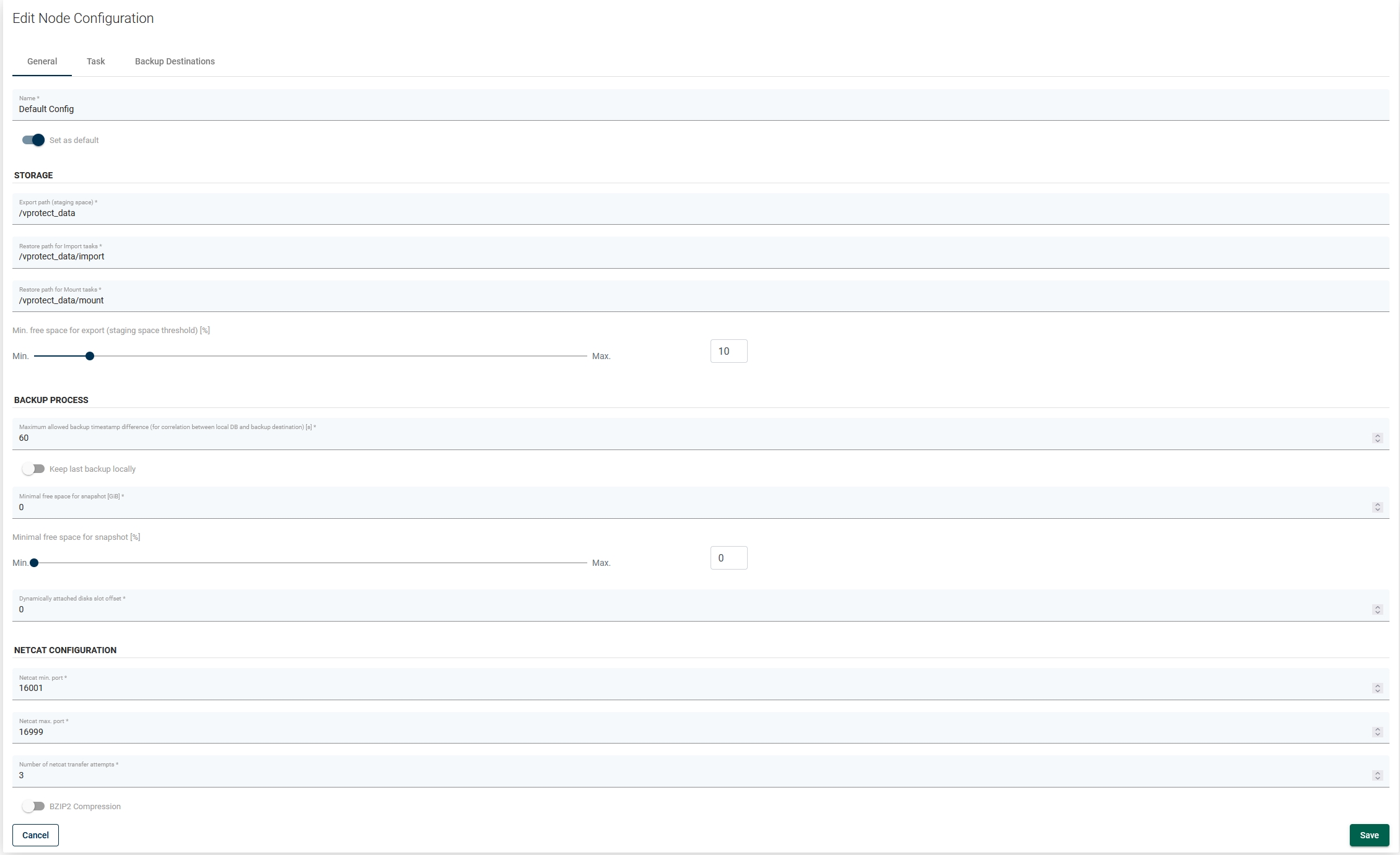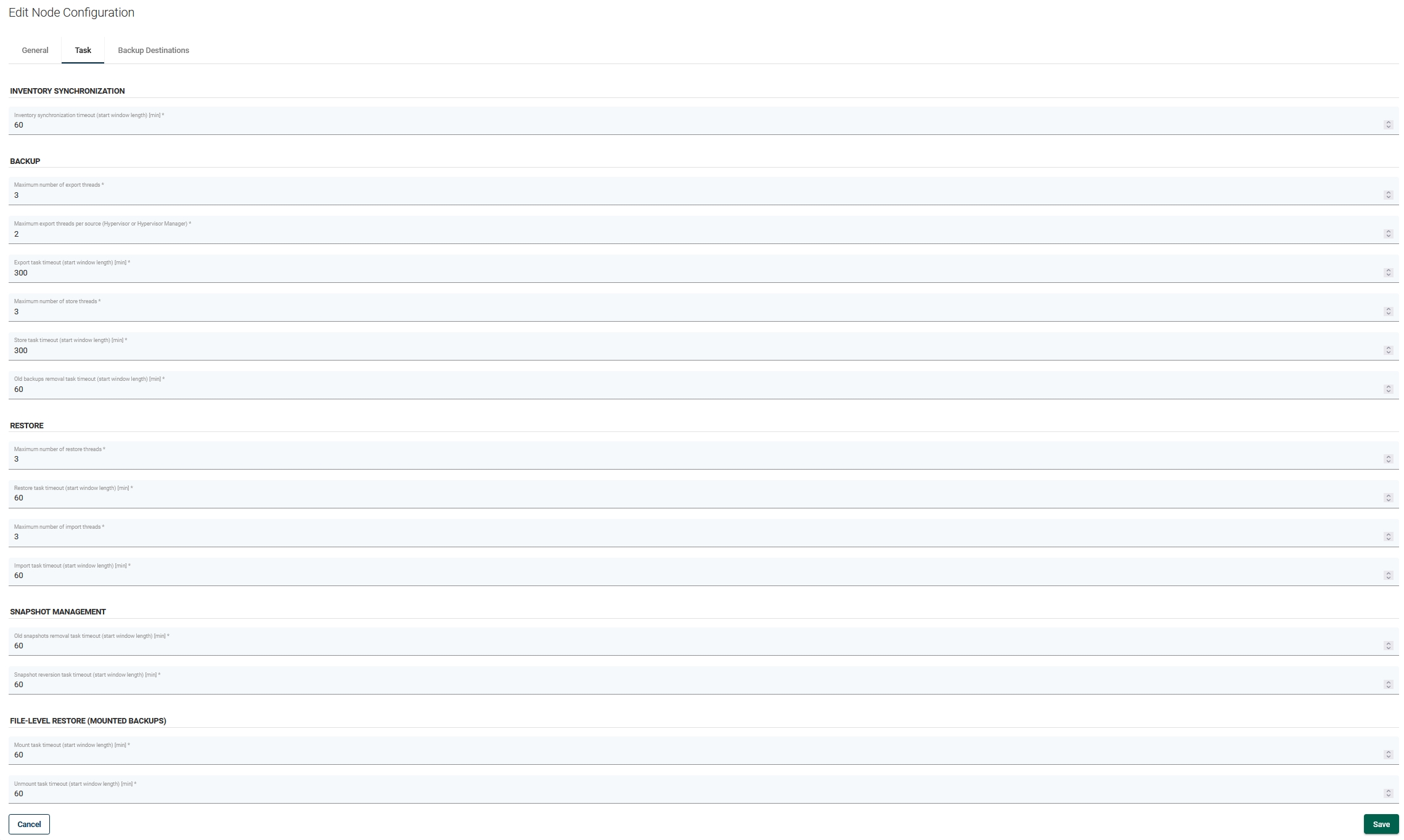Node Configurations
Node configurations are groups of settings assignable to a set of nodes. This is so that you don't have to change them on every node separately.

Available settings
General
Name- unique name identifying the configurationSet as default- set default configuration to be assigned to new nodes
Storage
Export path (staging space)- staging path (must be owned by thevprotectuser)Restore path for import tasks- in rare cases, you may want to restore backups to a custom location within the node before the import process beginsRestore path for mount tasks- in rare cases, you may want to restore backups to a custom location within the node before the mounting process beginsMin. free space for export [%]- the amount of storage space left in order to force a node to wait before starting another export task
Backup Process
Max. allowed backup timestamp difference [s]- maximum time difference between the timestamp of a backup in vPlus and the backup destination in order to match the local version of the backup with the remote oneMinimal free space for snapshot [GB]- the amount of storage space left in order to force a node to wait before starting another taskMinimal free space for snapshot [%]- the amount of storage space left in order to force a node to wait before starting another taskDynamically attached disks slot offset- this setting forces a shift of a disk slot number that the node reads/writes from when the disk-attachment method is used - currently used in the Nutanix disk-attachment method when you have block devices not reported by the hypervisor API, such as iSCSI mounted block devices. When set to 0, vPlus will mount drives just after the last occupied (and reported by the hypervisor API) slot (which means that block device number 3 in API will be /dev/sdc in OS). In general, N means that vPlus will shift N slots, so 1 will make the 3rd device be treated as the 4th in OS /dev/sdd)Netcat min. port- min. Netcat port rangeNetcat max. port- max. Netcat port rangeNumber of netcat transfer attempts- maximum number of attemptsBZIP2 Compression- compress backup files with bzip2

Task

INVENTORY SYNCHRONIZATION
Inventory synchronization timeout (start window length) [min]- default length of the start window for index tasks
BACKUP
Maximum number of export threads- max. number of export tasks per node (total)Maximum export threads per source (HV or HVM)- max. number of export tasks per node and per HV/HVMExport task timeout (start window length) [min]- default length of the start window for export tasksMaximum number of store threads- max. number of store tasks per nodeStore task timeout (start window length) [min]- default length of the start window for store tasksOld backups removal task timeout (start window length) [min]- default length of start window for old backup removal tasks
RESTORE
Maximum number of restore threads- max. number of restore tasks per node (total)Restore task timeout (start window length) [min]- default length of start window for restore tasksMaximum number of import threads- max. number of import tasks per node (total)Import task timeout (start window length) [min]- default length of the start window for import tasks
SNAPSHOT MANAGEMENT
Old snapshot removal task timeout (start window length) [min]- default length of start window for old snapshot removal tasksSnapshot reversion task timeout (start window length) [min]- default length of start window for snapshot reversion tasks
FILE-LEVEL RESTORE (MOUNTED BACKUPS)
Mount task timeout (start window length) [min]- default length of start window for mount tasksUnmount task timeout (start window length) [min]- default length of the start window for unmounting tasks
Backup destinations
This section is used to add/remove backup destinations to the nodes using this configuration. Only backup destinations enabled here can be used by the nodes.

Cloud Agent
This section is used to provide connection details to the Windows Helper Host, which is used to export to PST. You can find more information about requirements for Export to PST here.
Fill in the indicated fields:
Host - IP address of the Windows host where cloud2pst converter is installed
User - Windows host user
Password - Windows host user password
